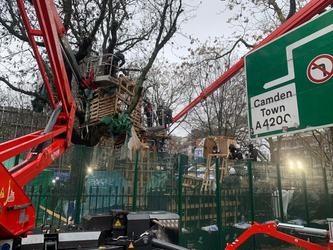Community engagement

Community engagement is a fundamental part of an infrastructure project, allowing the organisation to communicate openly, understand potential objections and look to address those where possible.
Whilst some engagement might be on social media or via a website, in-person meetings are a highly effective means of building relationships and listening to the local community.
People will attend such meetings for a wide range of reasons, one of them being to protest about the planned project.
How the National Eviction Team supports community engagement
When the National Eviction Team is instructed by a client, this is often the point at which we start our work – planning the community engagement to ensure that questions can be aired and answered and protesters can exercise their right to a peaceful protest in a safe, calm and approachable manner, without disturbing the main meeting.
There is often the perception that our work starts when the protesters are on site, perhaps up trees, in tunnels or locked on to structures. But in the majority of cases, our involvement starts much earlier, so that we can support the community engagement stage.
Our agents can be on site for large infrastructure projects, where protests are expected for a long time. During that time, we will build relationships with the client, their security team, the local community and sometimes the protesters themselves – there are many that we come across on different sites.
Nuclear power, wind farms and national infrastructure sites
When working with a nuclear power station on a development, our work started with managing protesters attending the public meetings, before moving on to removal from land just outside the site when construction commenced.
We have undertaken the same type of work very recently with some proposed wind farm developments and last year we supported a road development public meeting to move placard holders to outside the meeting hall, so that they could hold their protest without disrupting the meeting.
With all the work we work we undertook supporting HS2, this started with the public meetings and community engagement, before moving on to removing protesters from tunnels at Euston Square Gardens and other sites along the route.
Community engagement at Sweets Way
You can read more about our community engagement when working to evict squatters from Sweets Way, where we worked very closely with the police and Barnet Council on the planning and execution of the eviction, as there were knock-on implications for the wider community.
There were public footpaths through the site, a primary school nearby, as well as several highways which made this a very complex case.
We liaised closely with the head teacher of the primary school about access, which would normally have been across the site, to ensure that pupils, parents and teachers could go to and from school safely using alternative routes.
We also helped to educate dog walkers about going onto the site. We did have permission to stop them, but we mainly tried to dissuade them from walking there and the Council was able to change the footpaths.
Find out more
If you are planning public meetings to consult and engage with the local community, please get in touch for guidance and support.



